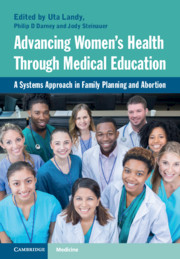 Advancing Women's Health Through Medical Education
Advancing Women's Health Through Medical Education The Benefits of Integrating Research Training into Fellowship in Family Planning Programs
from Section I - Abortion Training: Workforce, Leadership, Social & Political Impact
Published online by Cambridge University Press: 30 July 2021
Medical research is the basis of better health for the world’s people.Family planning provides among the best examples of the powerful association between research and health.Modern contraception and safer abortion are direct products of fifty years of basic and clinical, laboratory and population-based, research.Over the past 20 years training specifically for contraception and abortion research has created a “new generation” of investigators who are building the “evidence-base” for contraceptive and abortion care.This chapter identifies some of the most important contributions of the graduates of “The Fellowship in Family Planning” and their colleagues at leading medical schools and hospitals, WHO, CDC and other research organizations.It describes their training in research methods and the impact it has had on clinical practice and women’s health worldwide.
To save this book to your Kindle, first ensure [email protected] is added to your Approved Personal Document E-mail List under your Personal Document Settings on the Manage Your Content and Devices page of your Amazon account. Then enter the ‘name’ part of your Kindle email address below. Find out more about saving to your Kindle.
Note you can select to save to either the @free.kindle.com or @kindle.com variations. ‘@free.kindle.com’ emails are free but can only be saved to your device when it is connected to wi-fi. ‘@kindle.com’ emails can be delivered even when you are not connected to wi-fi, but note that service fees apply.
Find out more about the Kindle Personal Document Service.
To save content items to your account, please confirm that you agree to abide by our usage policies. If this is the first time you use this feature, you will be asked to authorise Cambridge Core to connect with your account. Find out more about saving content to Dropbox.
To save content items to your account, please confirm that you agree to abide by our usage policies. If this is the first time you use this feature, you will be asked to authorise Cambridge Core to connect with your account. Find out more about saving content to Google Drive.